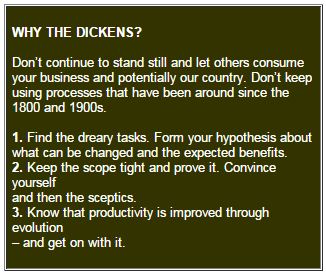Published on the 23/12/2009 | Written by Mobico

GM of leading NZ mobile solutions provider Mobico, Aldas Palubinskas, is passionate about productivity. He discusses how leading NZ businesses can achieve real world productivity gains and how they can get the dickens out of their day…
Do you sometimes wish your people were more like machines, robots, worker bees or soldier ants? Why do people have to have feelings, good days, bad days, pride and goals? How come there are still so many jobs that require staff to do menial and highly repetitive tasks. For example, moving goods, or recording details about tasks.
Every day, in New Zealand, millions of these repetitive tasks are performed. This is the backbone of modern life. But it is often dreary and boringly repetitive work.
Could you do it, day after day, year after year? Thankfully, life is probably not a Dickens novel for you or I, but it is staggering how many Victorian era paper-based practices remain in the modern workplace.
We can all talk about how government should improve productivity, but how many of us have really improved productivity within our own workplaces?
Is it up to you to change this? Will jobs continue to be lost as larger and/or offshore companies swallow up NZ companies, because they fail to invest in technology to streamline necessary but error-prone menial repetitive tasks? What can you do?
Changing business processes is certainly hard. It can feel like trying to get out of a moving car because there is so much momentum. But it need not be like this. Here are three simple steps to improving productivity. These are based on how the leading businesses we work with and the “agents of change” that work within them do it. It’s a simple, proven and potent approach.
1. Find it
2. Prove it
3. Do it
1. FIND IT
If you’ve read previous features or case studies, you may recall Mobico specialises in handheld mobile computers. The majority of the 20,000 or so units they look after throughout NZ are doing the most boring jobs in the country. You might say:
“What they do isn’t innovative, it’s repetitive”.
So, what are the most repetitive tasks in your organisation?
• If you are a service company, it’s scheduling jobs, recording time and replacing parts
• If you are a wholesaler or retailer, it is replacing stock
• If you are in freight or warehousing, it is moving stock
• If you are a hospital, it will be ordering/replacing supplies, recording details and cleaning
• If you are a council, it will probably be maintenance and inspections
• If you are a hotelier, cleaning rooms and restocking the mini-bar
Large parts of your organisation’s people and capital are committed to similar tasks every day.
They are repetitive, but always need to be done on time, with accuracy and care. Every day, year after year.
FORM YOUR HYPOTHESIS:
“We can reduce shipping errors by 90%”
“We can reduce stocktake time from 24 hours to 4 hours”
“We can make two additional customer visits per person, per day”
“We can reduce stock losses by 50%”
“We can reduce the time to complete the task by 20%”
“We can reduce inventory by 15%”
Once you have agreed on a theoretical target, work through what the business benefit is. Be specific. Productivity gains are typically evolutionary, not revolutionary in size and value. If your hypothesis is credible, you will be able to theorise repeatable benefits, but typically they may be “small”.
Such benefits frequently range from $20 to $50 per task worker, per day. While costs to achieve them are around $10 per day. People can often lose heart at this stage, feeling that it will take a lot of work and cost to achieve what on the face of it looks to be quite a small gain.
Using a handheld mobile computer improves the quality and consistency of these tasks. These reduce errors, eliminate double-handling (ie. the re-keying of data) and speed up service. But, perhaps most importantly, they take some of the drudgery away from the tasks.
However, $20 to $50 is actually a very large gain. Did you know $30 per person, per day easily extrapolates to the equivalent of $200,000 per year in extra sales. Consider this: average net earnings are often less than 5% of revenue and, in most cases, the benefits proposed can be viewed as flowing directly to the bottom line, given they are normally a direct cost of sale or operating cost reductions. So, $30 divided by 5% = $600 per day x 365 days, or 250, depending on your company.

So, do the maths. Also take into account the compounding effect. However, you look at it there will be a good return. So, keep believing in it.
2. PROVE IT
With a clear hypothesis, like any scientist, you will need to prove it. Think about the processes around this task. But not too many of them. The secret to a successful mobility project is to keep the scope tight and the concept simple.
This can also be said about many projects, but specifically with mobility the tasks being improved on are repetitive.
Start with the most simple repetitive task. You can always add other tasks later. Also keep the error handling process simple and ideally not on the mobile computer. For example, when doing a stocktake, if the item you’ve just scanned isn’t recognised, just take it to the stocktake supervisor.
Don’t design your stocktake application to add the item as this will complicate the process and potentially introduce data integrity issues.
Once you have a tight scope and functional specification, it is then very easy and cheap to build a prototype/proof-of-concept mobile application and run it on borrowed or rented equipment. Once you have this, you can then work through your new improved process recording the results and findings. Then record the same process done the current way and estimate the savings.
EXAMPLES:
“We ran the proof of concept order picking system for 2 weeks. We found orders took on average 8 minutes less to pick and every order was 100% accurate. Without the order picking system 5 out of every 100 orders had issues.
Based on 25 orders per day per person, we estimate the system will save 100 minutes per day in picking, plus at least 20 minutes per day sorting out incorrectly picked orders. This improves our performance by 2 hours x $20 per hour = $40 per day”.
“Our stocktake used to take 6 people 4 hours for 4 nights.
That’s 96 hours. What’s more the stock changed as we opened during the day. We put in the stocktake system, it now takes 4 people 4 hours. That’s a saving of 80 hours and we get it done all in one night, so the stock is accurate.
The time saving alone is worth $1,200 each stock take”.
“The technician saves on average 8 minutes per job. They do 7 jobs per day. Saving 4 minutes 7 times per day means we save 56 minutes per day, which allows us to squeeze in an extra job most days, which generates an average of $70 per day extra”.
3. DO IT
Great. You’ve found out how to save some money, or make some more. Is this the moment of truth? Is $30 per day, per worker enough benefit to get the project approved? It adds up to a lot extra on the bottom line at the end of the year – or does it? What is your threshold?
Some businesses will do it for $10 and some will easily get $100 or more. However, many businesses seem to feel that $30+ per day, per task worker is not enough of a benefit to pursue. Did you know most mobility projects have an ROI of less than 12 months, but they take on average 4 years to get the go ahead. There’s always plenty of excuses:
EXCUSES EXCUSES:
“We can’t reduce head count, so it isn’t a real saving”
“We just need to try harder and reduce errors”
“Everyone does it the way we do, so why should we change?”
“It’s not in this year’s budget”
“If we are going to do that, we also need to do this and this and this”
These are the same reasons that government departments find it hard to change. Is your business the same? Have modern business management practices paralysed common sense decision making?
Improved productivity is not a destination, it is a journey.
Make some decisions, follow in the steps of others and enjoy the benefits of their learning.
Start focused and expand the scope over time.
Provide your workforce with tools that improve the menial, task-based jobs, that even make them fun.
FOR MORE INFORMATION
Mobico
W: www.mobico.biz
E: info@mobico.biz
T: +64 9 303 0686
Mobico is NZ’s largest specialist handheld mobile-computer and wireless-network provider. It has installed – and supports – over 700 wireless networks across NZ, operating 20,000 handheld mobile-computers.




























